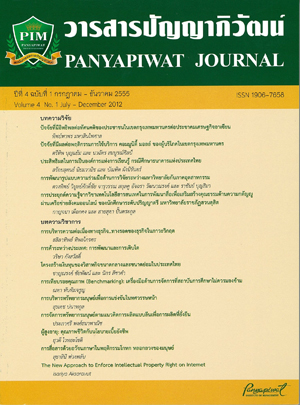ผู้สูงอายุ : คุณภาพชีวิตกับนโยบายเบี้ยเลี้ยงชีพ
Main Article Content
บทคัดย่อ
วัยสูงอายุเป็นพัฒนาการขั้นหนึ่งของชีวิตมนุษย์ ซึ่งมีการเปลี่ยนแปลงอย่างค่อยเป็นค่อยไป แต่ละช่วงของการเปลี่ยนแปลงจะมีผลกระทบต่อสภาพร่างกาย จิตใจ อารมณ์ และสังคม ของผู้สูงอายุเป็นอย่างมาก ทำให้ผู้สูงอายุที่มีความเปราะบางอยู่แล้วได้รับผลกระทบมากขึ้น ทั้งนี้หากผู้สูงอายุปรับตัวได้ทันกับการเปลี่ยนแปลงที่เข้ามาในชีวิตได้ดีก็จะสามารถดำเนินชีวิตได้อย่างมีความสุข เกิดความพึงพอใจในชีวิต (Life Satisfaction) เป็นการสะท้อนให้เห็นถึงคุณภาพชีวิตของผู้สูงอายุ ซึ่งในการศึกษาด้านวิทยาการผู้สูงอายุ (Gerontology) มักใช้ความพึงพอใจในชีวิตเป็นตัวชี้วัดถึงคุณภาพชีวิตของผู้สูงอายุ อย่างไรก็ตามปัจจุบันพบว่า ประชากรคนไทยประมาณ 2 ใน 3 ของประชากรทั้งหมดไม่มีหลักประกันใดๆ รวมถึงหลักประกันด้านรายได้ยามชราภาพ ขณะที่เบี้ยยังชีพที่ได้รับยังต่ำกว่าเส้นความยากจน
Aging is one of human life development which gradually changes. In each period of changes, it mostly influences on physical and mental health, emotions, and socialization of our senior citizens that causes greater impact on the senior citizens who are brittle temperaments. Somehow, if the senior citizens are able to cope with this change, they can move on and be fulfilled with happiness. That leads to life satisfaction which reflects the quality of life of our senior citizens. In view of gerontology, life satisfaction is an indicator of quality of life of the senior citizens. However, in the era it is found that two thirds (2/3) of the total Thai population have no any collateral including their guaranteed income when old age. While the payment of allowance sits below the poverty line.
Article Details
“ข้าพเจ้าและผู้เขียนร่วม (ถ้ามี) ขอรับรองว่า บทความที่เสนอมานี้ยังไม่เคยได้รับการตีพิมพ์และไม่ได้อยู่ระหว่างกระบวนการพิจารณาลงตีพิมพ์ในวารสารหรือแหล่งเผยแพร่อื่นใด ข้าพเจ้าและผู้เขียนร่วมยอมรับหลักเกณฑ์การพิจารณาต้นฉบับ ทั้งยินยอมให้กองบรรณาธิการมีสิทธิ์พิจารณาและตรวจแก้ต้นฉบับได้ตามที่เห็นสมควร พร้อมนี้ขอมอบลิขสิทธิ์บทความที่ได้รับการตีพิมพ์ให้แก่สถาบันการจัดการปัญญาภิวัฒน์หากมีการฟ้องร้องเรื่องการละเมิดลิขสิทธิ์เกี่ยวกับภาพ กราฟ ข้อความส่วนใดส่วนหนึ่งและ/หรือข้อคิดเห็นที่ปรากฏในบทความข้าพเจ้าและผู้เขียนร่วมยินยอมรับผิดชอบแต่เพียงฝ่ายเดียว”
เอกสารอ้างอิง
เกรียงศักดิ์ เจริญวงศ์ศักดิ์. (2008). นโยบายสวัสดิการสังคมของสิงคโปร์. สืบค้นเมื่อ 9 กันยายน 2555 จาก http://www.eastasiawatch.in.th/article.php?section=4&id=20
รศรินทร์ เกรย์ และกุ้งทอง ครามานนท์. (2550).“นโยบายการเพิ่มภาวะเจริญพันธุ์ของประเทศญี่ปุ่น และเกาหลีใต้ : ใช้งบประมาณสูงมากแต่ยังไม่ ประสบความสําเร็จ” ใน ประชากรและสังคม. วรชัย ทองไทย และสุรีย์พร พันพึ่ง บรรณาธิการ. นครปฐม สํานักพิมพ์ประชากรและสังคม.
วรรณภา ศรีธัญรัตน์ และผ่องพรรณ อรุณแสง. (2545)การสังเคราะห์องค์ความรู้เพื่อจัดทําข้อเสนอ การปฏิรูประบบบริหารสุขภาพและการสร้าง หลักประกันสุขภาพสําหรับผู้สูงอายุไทย ขอนแก่นคลังนานาวิทยา.
วรเวศม์ สุวรรณระดา. (2552, 19 มกราคม). คอลัมน์ระดมสมอง, ประชาชาติธุรกิจ, 32(4072).
Barrow, G.M. and Smith, P.A. (1997). Aging Ageismand Society. St. Paul, Minn: West.
Gilmor, G.D. & Campbell, M.D. (1996). Need Assessment Strategies for Health Education and Health Promotion. 2nd ed. Sudbury,MA: Jones & Bartlett Learning.
Johnson, T. (1995). Aging well in contemporary society. American Behavioral Scientist,39(2), 120-130.
Kim, Tai-Hun. (2006). Population Size and Structure. Korean Statistical Association.
Miller, S.S., et al. (1986). Life Span Plus: The Definitive Guide to Health and Well Being for the Rest of You Life. New York: Macmillan.
Powell, B.H. (1983). Understanding Human Adjustment Normal Adaptation through the Life Cycle. Boston: Little Brown.
Seedsman, Terence. (2002). Aging Well in the 21st Century: Challengers and perspectives for Adult Education in Thailand. เอกสาร ประกอบการประชุมทางวิชาการเรื่อง “การพัฒนา ชีวิตอย่างมีคุณค่าในเวลาสูงวัย” วันที่ 13 กันยายน
ณ โรงแรมบางกอกพาเลซ กรุงเทพฯ.
Shelly, M.W. (1975). Responding to Social Change. Pennsylvania: Dowden, Hutchinson and Ross.
Wolman, B.B. (1973). Dietionary of Behavioral Seience. Van Nestrand: Reinhold.


